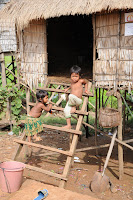
I have not blogged in a couple of days. I have been busy right up until bedtime, not to mention exhausted. Hauling 45 pounds of camera gear around the temples is no easy task, and combine it with 100-degree heat and air thick enough to take a bite out of, and that’s a recipe for exhaustion. Tiredness aside, these past two days have been brimming with activity.
School in Cambodia runs six days a week. On Saturday I should have gone to the school, but since my temple pass expires on Monday, Ponheary convinced me it made better sense to wait to return to the school until I had seen all the temples I wanted to see. I think that was good advice.

I called Vanney, the young man I hired to be my driver while in Siem Reap, and had him take me to all the remote temples. I saw Preah Khan, Neak Pean, Ta Som, East Mebon, and Pre Rup. I drank about 3 liters of water. I didn't go to the bathroom once, but I was drained from the sun and drenched from head to toe. We were done by Noon, and while I was waiting for my pictures to transfer from my memory card in my room, I laid down. Big mistake. I woke up at 7 p.m.

Sunday I took a trip to Phnom Kulen waterfall deep in the Cambodian jungle atop a mountain. For those who had temple passes, we stopped at Banteay Srei temple, which is on the way. I went with a group of students from the U.S. who are staying at Ponheary’s guest house and working as English teacher volunteers at another local elementary school in Siem Reap. They are young, but what a great group!

Phnom Kulen was a glimpse into Cambodian recreational culture. We were the only Westerners who had a pavilion. Phnom Kulen is a popular Sunday destination for middle-income families, who rent bungalows and have a picnic while the kids swim and play. We had a picnic with Ponheary’s family, and got to explore the waterfalls. I made my way along the slippery rocks to a good vantage point where I was more interested in taking pictures than swimming. I managed to snap a couple of good ones, and Ponheary got one of me.
The first photo of Phnom Kulen (at the top of this post) shows some monks visiting the falls. In Cambodia, every family sends the eldest boy to serve as a monk for three months at some point in his life. Some families send them young, and some wait until the boys are older; that is why you can see monks of all ages. Some monks remain in the monastery permanently, but most enjoy the time and go back to their families. I say enjoy the time, because being a monk has some cool perks for an otherwise poor Cambodian boy. Monks in Cambodia are very highly regarded, and get everything for free. They ride for free, they eat for free, and people give them food and money every morning to take back to the monastery and share. Monks also get to travel to other monasteries, the temples, or, in this case, the waterfalls of Phnom Kulen. I saw a busload of monks unload at Preah Khan. They were swarmed by tourists wanting photos, and a couple of photogs stalked them quietly like paparazzi. Out of respect I did not join my compadres in their pursuit of the monks, instead I let the monks be tourists in their own country. They came to visit the shrines, pay homage to the resident monks (if any), and to gaze in awe at the fruits of their ancestors’ labor. I simply could not resist the shot above, however. I justified it because they actually walked in front of my camera, so I assumed that was them giving me permission.

At the mountain’s summit, a reclining Buddha was carved in the 16th century, and a platform temple was constructed around it. It was a lot of steps, but very worth it!
Here is an interesting picture from the walkway to one of the temples I visited. A massive tree--bigger than any tree I have ever seen in my life--had been cut down. To understand just how gargantuan this stump is, consider that I have hung my hat on the left hand edge of it. Yeah, that tiny speck on the edge of the stump near the center of the photo is my hat!

Wish me luck, as I have one more chance with my 7-day temple pass at a sensational Angkor Wat sunrise. So far, there has been only one spectacular one, and I missed it.















